15.1: The Policy-Making Process
15.1.1: Issue Identification and Agenda Building
The first step of the policy process involves issues being turned into agenda items for policymaking bodies.
Learning Objective
Describe the various ways different issues can become the focus of concerted political attention
Key Points
- Few issues actually make it onto policy agendas but those that do are often a result of public outcry, crises, and the lobbying efforts of important interest groups.
- Issues must become agenda items for policymaking bodies, like legislatures and administrative agencies, in order to proceed into the next stages of the policy process.
- Policy agendas are ephemeral and can easily be replaced by other issues when crises arise.
Key Terms
- public policy
-
The set of policies (laws, plans, actions, behaviors) of a government; plans and methods of action that govern that society; a system of laws, courses of action, and priorities directing a government action.
- agenda setting
-
a theory that describes the news media’s ability to shape which issues their audience thinks are important, based on their frequency and level of coverage
- agenda
-
A temporally organized plan for matters to be attended to.
Many problems exist within the United States but few make it onto the public policy agenda. Those problems that do move onto the policy agenda must first be identified as salient issues. An issue can be broadly defined as a circumstance of reality not meeting a constituency’s expectations. The power of the group in question can affect whether an issue moves onto the policy agenda. For example, a problem encountered by a major political campaign donor can move a given issue more quickly onto the agenda than a problem encountered by a small interest group without great political clout.
In other instances, issues can move into the public spotlight and be forced onto the policy agenda by the amount of attention and public outcry they receive. The media can be particularly effective in accomplishing this task. For example, widespread reporting on the number of Americans affected by tainted eggs and spinach moved the food safety system onto the policy agenda and resulted in a law that allocated greater authority to the Food and Drug Administration. The media can also keep issues off of the policy agenda by giving the impression that an issue does not require resolution through the policy process.
In addition to the power of certain groups and the media, significant events can act as policy triggers that immediately move issues onto the policy agenda. The terrorist attack in New York City on 9/11/2001 is an example of an event that brought terrorism, national security, weapons of mass destruction, and relations toward Iraq to the forefront of the national and international policy agendas.
In all of the aforementioned examples, issues have a high likelihood of becoming agenda items. Issues must become agenda items for some policymaking body in order to enter the policy cycle. These policymaking bodies may be a legislature, (e.g., a city council) or an administrative agency, (e.g., a health department).
It is important to note, however, that not all issues that move onto policy agendas complete the policy process to become laws. Indeed, agendas are subject to timing and can easily be displaced by other issues when crises occur. For example, Obama’s planned policy to loosen restrictions on coastal drilling was dropped after the BP oil spill occurred in the Gulf of Mexico . Those issues that withstand any significant crisis, though, will move onto the next stage of the policy process, formulation.

BP Oil Spill
The BP oil spill is an example of a crisis that changed the national policy agenda by reversing Obama’s planned policy to loosen restrictions on coastal drilling.
15.1.2: Policy Formulation
Formulation is the second stage of the policy process and involves the proposal of solutions to agenda issues.
Learning Objective
Identify the considerations that shape the formulation of first-best policy
Key Points
- Formulation often provides policymakers with several choices for resolving agenda items.
- Effective policy formulation is comprised of analysis that identifies the most effective policies and political authorizations.
Key Terms
- formulation
-
the second stage of the policy process in which policymakers propose courses of action for addressing agenda issues.
- policymaker
-
one involved in the formulation of policies, especially politicians, lobbyists, and activists.
Formulation of policy consists of policymakers discussing and suggesting approaches to correcting problems that have been raised as part of the agenda. Sometimes it is necessary to choose from among multiple potential paths forward. The issue of traffic safety has been solved by various policies throughout time. Here are a few examples of solutions: more highways were built in the 1950s , safer cars were required in the 1960s, and jailing drunk drivers was the solution in the 1980s and 1990s.

1950s Highways
Building highways is one example of a policy that was used to address the issue of traffic safety.
The ultimate policy that is chosen to solve the issue at hand is dependent on two factors. First, the policy must be a valid way of solving the issue in the most efficient and feasible way possible. Effective formulation involves analysis and identification of alternatives to solving issues. Secondly, policies must be politically feasible. This is usually accomplished through majority building in a bargaining process. Policy formulation is, therefore, comprised of analysis that identifies the most effective policies and political authorization.
15.1.3: Policy Adoption
Policy adoption is the third phase of the policy process in which policies are adopted by government bodies for future implementation.
Learning Objective
Identify which groups can expedite or retard the adoption of policy
Key Points
- Congress plays a minimal role in policy adoption since it cannot initiate policies the way the president can.
- The president has the sole ability of initiating new national policies.
Key Terms
- policy
-
A principle of behaviour, conduct etc. thought to be desirable or necessary, especially as formally expressed by a government or other authoritative body.
- adoption
-
The choosing and making that to be one’s own which originally was not so; acceptance; as, the adoption of opinions.
The Process of Adoption
Formulated policies have to be adopted by relevant institutions of government in order to be put into effect. Adoption can be affected by the same factors that influence what issues move into the earlier phase of agenda building. For instance, policies thataddress the changed circumstances crises often bring can often be immediately adopted. Meanwhile, powerful interest groups can use their political influence to determine what policies are adopted.
The media can also play a key role in policy adoption. When reporting and commentary is unbiased it can provide a forum where debate over various cases for policy adoption takes place. When the media displays a favorable bias, it can enhance a policy proposal’s likelihood of adoption. On the other hand, an unfavorable media bias may undermine a policy proposal. For example, unfavorable media coverage undermined the George W. Bush administration’s proposals to change Social Security. Negative response also killed the Clinton administration’s health care proposal.
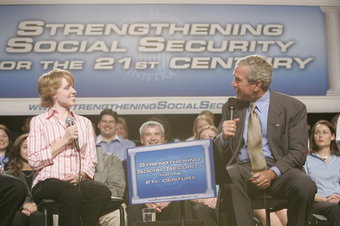
George W. Bush Social Security Discussion
Negative media attention toward George W. Bush’s plan for Social Security prevented policy adoption.
Governors or mayors can adopt policies to bring about change on a state or local level. However, the president has the sole responsibility of determining what policies are adopted on a nationwide level. Congress has some influence over policy adoption, as it must approve the president’s actions. Once the relevant government bodies adopt policies, they move into the next phase of the policy process, policy implementation.
15.1.4: Policy Implementation
Policy implementation is the fourth phase of the policy cycle in which adopted policies are put into effect.
Learning Objective
Describe how policies are implemented and the challenges that accompany the process
Key Terms
- policy
-
A principle of behaviour, conduct etc. thought to be desirable or necessary, especially as formally expressed by a government or other authoritative body.
- implementation
-
The process of moving an idea from concept to reality. In business, engineering and other fields, implementation refers to the building process rather than the design process.
How Policies are Implemented
The implementation of policy refers to actually enacting the proposed solutions. Whether a given policy has been implemented successfully depends on three major criteria:
- A policy needs to be communicated from the creator (e.g., a local official, or the President) to the relevant governing body within the bureaucracy that has the power to enact it. Thus, a policy designed to enforce traffic safety by cutting down on the number of drunk drivers would be passed down to law enforcement officials for implementation. When no existing agency has the capabilities to carry out a given policy, new agencies must be established and staffed. This is reflected most clearly in the “alphabet soup” agencies established by Franklin D. Roosevelt under the New Deal.
- Second, a policy needs to be communicated clearly and easy to interpret if it is to be implemented effectively. Too much ambiguity in this stage can lead to involvement by the judiciary that will force legislators to clarify their ends and means for policy implementation. The judiciary may overrule the implementation of such policies.
- Finally, the resources applied to implementation must integrate with existing processes and agencies, without causing extensive disruption, competition, or conflict.
In addition to the aforementioned elements, policy implementation can further be complicated when policies are passed down to agencies without a great deal of direction. Policy formulation is often the result of compromise and symbolic uses of politics. Therefore, implementation imposes a large amount of both discretion and confusion in agencies that administer policies. In addition, bureaucratic incompetence, ineptitude, and scandals may complicate the policy implementation process.
The above issues with policy implementation have led some scholars to conclude that new policy initiatives will either fail to get off the ground or will take considerable time to be enacted. The most surprising aspect of the policy process may be that policies are implemented at all.
15.1.5: Policy Evaluation
Policies must be evaluated once in place, but still tend to become entrenched over time and often do not receive any kind of evaluation.
Learning Objective
Summarize two key challenges in assessing policies
Key Terms
- empirical
-
Pertaining to, derived from, or testable by observations made using the physical senses or using instruments which extend the senses.
- policy
-
A principle of behaviour, conduct etc. thought to be desirable or necessary, especially as formally expressed by a government or other authoritative body.
Introduction
Policies may be evaluated according to a number of standards. They may be informally evaluated according to uncritical analysis, such as anecdotes and stories. Policies may also be substantively evaluated through careful, honest feedback from those affected by the policies. More formal research can provide empirical evidence regarding the effectiveness of policies. Finally, scientific research provides both comparative and statistical evaluations of whether policies produce clear causal results.
Policy evaluation can take place at different times. Administrators seeking to improve operations may assess policies as they are being implemented. After policies have been implemented they can be further evaluated to understand their overall effectiveness.
In spite of the many ways policies may be evaluated, they are often not evaluated at all. Formal and scientific research is time consuming, complicated to design and implement, and costly. While more informal evaluations focused on feedback and anecdotes are more accessible, they also tend to be contaminated with bias.
Challenges in Assessing Policies
Policies can be difficult to assess. Some policies aim to accomplish broad conceptual goals that are subject to different interpretations. Healthy air quality, for example, can be difficult to define in ways that will be universally accepted. Policies may also contain multiple objectives that may not be compatible. For example, two of the objectives of the 1996 Telecommunications Act were creating jobs and reducing cable rates. If sufficient amounts of revenues are not made, companies must either cut jobs to maintain low rates or must raise rates to create more jobs. Policies that do have compatible objectives can still be difficult to evaluate when only a few of the objectives are accomplished. One person may deem the policy successful for accomplishing some of the objectives, while another may deem the policy unsuccessful for not accomplishing all of the objectives.
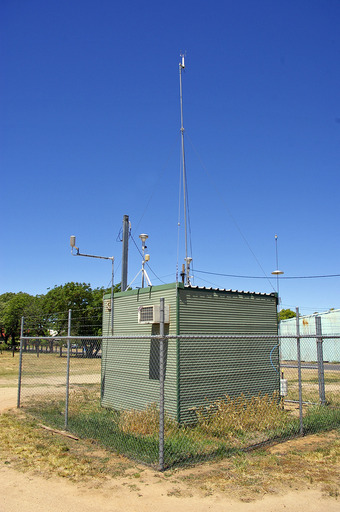
Air Quality
Broad conceptual goals, like healthy air quality, are difficult to evaluate since people may have different opinions on what “healthy” entails.
In general, public policies become entrenched over time and are difficult to terminate even if they are evaluated by various standards.
15.1.6: Policy Making and Special Interests
Interest groups that can advance their cause to the policymaking process tend to possess certain key traits.
Learning Objective
Describe the formation of special-interest groups and their role in the creation of policy
Key Points
- Special interest groups can range from think tanks, certain demographic sectors of the U.S. population, business groups, environmentalists, and foreign governments.
- Many interest groups compete for the attention of policymakers. Conflict between interest groups is, therefore, common.
- Key factors possessed by powerful special interest groups include: a large number of constituents, organizational skills, access to resources, links to government officials that will represent their cause, sheer intensity, and skill in accessing and convincing policymakers.
Key Terms
- lobbying
-
Lobbying (also lobby) is the act of attempting to influence decisions made by officials in the government, most often legislators or members of regulatory agencies.
- demographic
-
A demographic criterion: a characteristic used to classify people for statistical purposes, such as age, race, or gender.
Many different types of groups attempt to influence United States policy. For instance, certain demographic groups may favor policies that benefit them the most. Other groups may create formal institutions, known as think tanks, to advance their cause. Foreign governments can also behave as interest groups when it comes to U.S. foreign policy. For instance, Saudi Arabia launched a lobbying campaign to improve its image in the United States after it came under criticism for failing to crack down on terrorist groups after the 9/11 attack in New York.
Because of the wide variety of special interest groups, conflict between groups on an issue is common. The debate over creating free trade areas, like the North American Free Trade Agreement (NAFTA) , placed business groups in competition with labor and environmental groups in garnering the attention of policymakers toward their divergent causes.
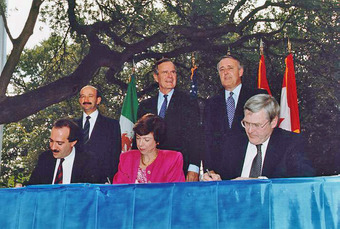
NAFTA Member Countries
The NAFTA initialing ceremony, in October 1992. Events, such as the signing of the North American Free Trade Agreement (NAFTA), highlight the differences among special interest groups and the competition that takes place between them to capture the attention of policymakers.
Those interest groups that are able to advance their causes to the policy agenda must possess certain key factors. Political scientist Charles O. Jones has organized these factors into six categories. First, the number of people affected plays a role in what policies are adopted. For example, senior citizens often make their demands onto the policy agenda because of their large numbers and inclination to vote. The extent to which constituents are organized and the resources available to them serve as other factors that influence whether interest groups can advance their causes to the policy agenda. A fourth factor is whether government representatives exist that can link interest groups and their problems with governmental processes.
The skills that interest groups utilize to advance their causes are also important in accessing the policymaking process. Many organizations only employ the most experienced and capable lobbyists to represent their causes. Meanwhile, the sheer intensity of interest groups can make up for inadequate resources or numbers of constituents.
15.2: Health Care Policy
15.2.1: Health Care Policy
The debate over access to health care in the United States concerns whether or not the government should provide universal health care.
Learning Objective
Discuss the structure and institutions responsible for creating health care policy
Key Points
- Health care facilities are largely owned and operated by private sector businesses. The government primarily provides health insurance for public sector employees.
- Active debate about health care reform in the United States concerns questions of the right to health care, access, fairness, efficiency, cost, choice, value, and quality. Some have argued that the system does not deliver equivalent value for the money spent.
- Publicly funded health care programs help provide for the elderly, disabled, military service families and veterans, children, and the poor. Federal law ensures public access to emergency services regardless of ability to pay.
- The resulting economy of scale in providing health care services appears to enable a much tighter grip on costs. The U.S., as a matter of oft-stated public policy, largely does not regulate prices of services from private providers, assuming the private sector to do it better.
Key Terms
- monopolistic
-
Acting in the manner of a monopoly.
- socialize
-
To take into collective or governmental ownership
Background
Health care policy can be defined as the decisions, plans, and actions that are undertaken to achieve specific health care goals within a society. According to the World Health Organization (WHO), an explicit health policy achieves several things: it defines a vision for the future; it outlines priorities and the expected roles of different groups; and it builds consensus and informs people.
In many countries individuals must pay for health care directly out-of-pocket in order to gain access to health care goods and services. Individuals of these countries also have to pay private sector players in the medical and pharmaceutical industries to develop research. The planning and production of health human resources is distributed among labor market participants.
Health care in the United States is provided by many different organizations. Health care facilities are largely owned and operated by private sector businesses. The government primarily provides health insurance for public sector employees. 60-65 percent of healthcare provisions and spending comes from programs such as Medicare, Medicaid, TRICARE, the Children’s Health Insurance Program, and the Veterans Health Administration. Most of the population under 65 is insured by his/her or a family member’s employer, some buy health insurance on their own, and the remainder are uninsured.
The current active debate about health care reform in the United States concerns questions of a right to health care, access, fairness, efficiency, cost, choice, value, and quality. Some have argued that the system does not deliver equivalent value for the money spent. The United States pays twice as much for health care, yet lags behind other wealthy nations in measures such as infant mortality and life expectancy. In fact, the United States has a higher infant mortality rate than most of the world’s industrialized nations.
The Role of Government in the Health Care Market
Numerous publicly funded health care programs help provide for the elderly, disabled, military service families, veterans, children, and the poor. Additionally, the federal law ensures public access to emergency services regardless of the ability to pay. However, a system of universal health care has not been implemented nation-wide. Nevertheless, as the Organization for Economic Co-operation and Development (OECD) has pointed out, the total U.S. public expenditure for this limited population would, in most other OECD countries, be enough for the government to provide primary health insurance for the entire population. Although the federal Medicare program and the federal-state Medicaid programs possess some monopolistic purchasing power, the highly fragmented buying side of the U.S. health system is relatively weak by international standards, and in some areas, some suppliers such as large hospital groups have a virtual monopoly on the supply side. In most OECD countries, there is a high degree of public ownership and public finance. The resulting economy of scale in providing health care services appears to enable a much tighter grip on costs. The United States, as a matter of oft-stated public policy, largely does not regulate prices of services from private providers, assuming the private sector could do it better.
Examples of Health Care Reform
Massachusetts has adopted a universal health care system through the Massachusetts 2006 Health Reform Statute. It mandates that all residents who can afford to purchase health insurance must do so, and it provides subsidized insurance plans so that nearly everyone can afford health insurance. The law also provides a “Health Safety Net Fund” to pay for necessary treatment for those who cannot find affordable health insurance or for those who are not eligible. In July 2009, Connecticut similarly passed a law called SustiNet, with the goal of achieving health-care coverage for 98 percent of its residents by 2014.
Advocates for single-payer health care often point to other countries, where national government-funded systems produce better health outcomes at a lower cost. A single-payer universal health care plan for an entire population can be financed from a pool to which many parties such as employees, employers, and the state have contributed. Opponents deride this type of system as socialized medicine, and it has not been one of the favored reform options by Congress or the President in both the Clinton and Obama reform efforts. It has been pointed out that socialized medicine is a system in which the government owns the means of providing medicine. Britain’s health care system is an example of this socialized system, along with the Veterans Health Administration program in America. Medicare is an example of a mostly single-payer system, as is France’s system. Both of these systems have private insurers to choose from, but the government is the dominant purchaser.
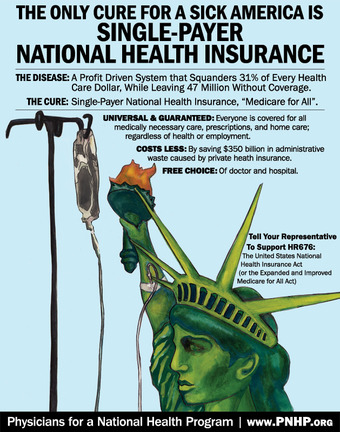
Physicians for National Healthcare Poster
Single payer health care poster about the United States National Health Care Act.
15.2.2: Medicaid and Medicare
Medicaid is a health program for people and families with low incomes and Medicare is for people over 65 and disabled.
Learning Objective
Compare and contrast Medicaid and Medicare as social programs provided by the U.S. government
Key Points
- Medicaid is the United States’ health program for certain people and families with low incomes and resources. It is a means-tested program that is jointly funded by the states and federal government; however, it is managed by the states.
- Medicare is a national social insurance program, administered by the U.S. federal government since 1965. It guarantees access to health insurance for Americans ages 65 and older in addition to younger people with disabilities and people with end stage renal disease.
- Beginning in the 1990’s, many states received waivers from the federal government to create Medicaid managed care programs. Under managed care, Medicaid recipients are enrolled in a private health plan, which receives a fixed monthly premium from the state.
- Medicare Advantage plans are required to offer coverage that meets or exceeds the standards set by the original Medicare program, but they do not have to cover every benefit in the same way.
- Unlike Medicare, which is solely a federal program, Medicaid is a joint federal-state program. Each state operates its own Medicaid system, but this system must conform to federal guidelines in order for the state to receive matching funds and grants.
- Medicare is a earned entitlement. Medicare entitlement is most commonly based on a record of contributions to the Medicare fund.
Key Terms
- per capita
-
shared equally among all individuals.
- disabled
-
those who are disabled, regarded collectively or as a social group.
Background
Medicaid is the United States’ health program for qualified individuals and families with low incomes and resources. It is a means-tested program that is jointly funded by the states and federal government; however, it is managed by the states. Medicaid serves people who are U.S. citizens or legal permanent residents, including low-income adults, their children, and people with certain disabilities. Poverty alone does not necessarily qualify someone for Medicaid. Medicaid is the largest source of funding for medical and health-related services for people with limited incomes in the United States.
Medicare is a national social insurance program, administered by the U.S. federal government since 1965. It guarantees access to health insurance for Americans ages 65 and older in addition to younger people with disabilities and people with advanced renal disease. Medicare has a different social role from for-profit private insurers, which manage their risk portfolio to maximize profitability by denying coverage to those they anticipate will need it. As a social insurance program, Medicare spreads the financial risk associated with illness across society in order to protect everyone. In 2008, the U.S. Federal Government spent $391,266,000,000 on Medicare.
Features
Beginning in the 1990’s, many states received waivers from the federal government to create Medicaid managed care programs. Under managed care, Medicaid recipients are enrolled in a private health plan, which receives a fixed monthly premium from the state. The health plan is then responsible for providing for all or most of the recipient’s healthcare needs. Today, all but a few states use managed care to provide coverage to a significant proportion of Medicaid enrollees. Nationwide, roughly 60% of enrollees are enrolled in managed care plans. Core eligibility groups of poor children and parents are most likely to be enrolled in managed care, while the elderly and disabled eligibility groups more often remain in traditional “fee for service” Medicaid.
Some states operate a program known as the Health Insurance Premium Payment Program (HIPP). This program allows a Medicaid recipient to have private health insurance paid for by Medicaid. As of 2008, only a few states had premium assistance programs and enrollment was relatively low. However, interest in this approach remained high.
Medicare Advantage plans are required to offer coverage that meets or exceeds the standards set by the original Medicare program, but they do not have to cover every benefit in the same way. If a plan chooses to pay less than Medicare for some benefits, like skilled nursing facility care, the savings may be passed along to consumers by offering lower co-payments for doctor visits. Medicare Advantage plans use a portion of the payments they receive from the government for each enrollee to offer supplemental benefits. All plans limit their members’ annual out-of-pocket spending on medical care, with a yearly limit of $6,700. Some plans offer dental coverage, vision coverage, and other services not covered by Medicare Parts A or B. These plans are a good value for the health care dollar, if an individual wants to use the provider included in the plan’s network.
Comparing Medicare and Medicaid
Unlike Medicare, which is solely a federal program, Medicaid is a joint federal-state program. Each state operates its own Medicaid system, but this system must conform to federal guidelines in order for the state to receive matching funds and grants. The matching rate provided to states is determined using a federal matching formula (called Federal Medical Assistance Percentages), which generates payment rates that vary from state to state, depending on each state’s respective per capita income. The wealthiest states only receive a federal match of 50% while poorer states receive a larger match.
Medicaid funding has become a major budgetary issue for many states over the last few years. On average, states spend 16.8% of their general funds on the program. If the federal match expenditure is also counted, the program usually takes up 22% of each state’s budget.
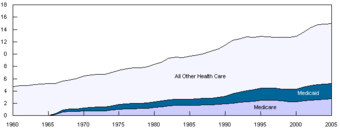
U.S. Healthcare GDP
Spending on U.S. healthcare as a percentage of gross domestic product (GDP).
Medicare is a earned entitlement. Entitlement is most commonly based on a record of contributions to the Medicare fund. As a result, it is a form of social insurance that makes it feasible for people to pay for insurance for sickness in old age. They contribute to the fund when they are young and able to work. Medicare offers assurance that contributing individuals will receive benefits when they are older and no longer working. Some people will pay in more than they receive back and others will get back more than they paid in, but this is the practice with any form of insurance, public or private.
15.2.3: Universal Coverage
Universal healthcare coverage provides healthcare and financial protection to all citizens; however the United States has not adopted it.
Learning Objective
Explain how universal healthcare works as a national health care policy and the arguments made for and against it
Key Points
- Universal healthcare–sometimes referred to as universal health coverage, universal coverage, universal care or social health protection–usually refers to a healthcare system that provides healthcare and financial protection to all citizens.
- Proponents of healthcare reforms that call for the expansion of government involvement in order to achieve universal healthcare argue that the need to provide profits to investors in a predominantly free-market health system, and the additional administrative spending, tends to drive up costs.
- The United States has instead adopted a single-payer system for healthcare. The term single-payer healthcare is used in the United States to describe a funding mechanism meeting the costs of medical care from a single fund.
Key Term
- coverage
-
The amount of space or time given to an event in newspapers or on television
Background
Universal healthcare–sometimes referred to as universal health coverage, universal coverage, universal care, or social health protection–usually refers to a healthcare system that provides healthcare and financial protection to all citizens. It is organized to provide a specified package of benefits to all members of a society with the end goal of providing financial risk protection, improved access to health services, and improved health outcomes. Universal healthcare is not a one-size-fits-all concept, nor does it imply unlimited coverage for all people. Three critical dimensions can determine universal healthcare: who is covered, what services are covered, and how much of the cost is covered.
Universal healthcare systems vary according to the extent of government involvement in providing care and/or health insurance. In some countries, such as the United Kingdom, Spain, Italy, and the Nordic countries, the government has a high degree of involvement in the commissioning and delivery of healthcare services. In these countries, access is based on residence rights, and not on the purchase of insurance. Other countries have a much more pluralistic delivery system of obligatory health insurance, with contributory rates based on salaries or income and usually funded jointly by employers and beneficiaries . Sometimes the healthcare funds are derived from a combination of insurance premiums, salary-based mandatory contributions by employees and/or employers to regulated sickness funds, and by government taxes.
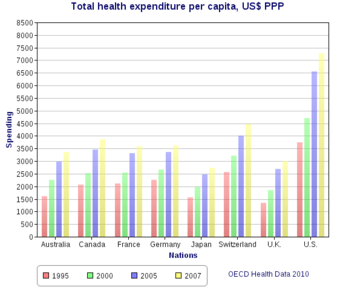
Total Health Expenditure Per Capita, US Dollars
This image depicts the total healthcare services expenditure per capita, in U.S. dollars PPP-adjusted, for the nations of Australia, Canada, France, Germany, Japan, Switzerland, the United Kingdom, and the United States with the years 1995, 2000, 2005, and 2007 compared.
Proponents of Universal Healthcare in the United States
Proponents of healthcare reforms that call for the expansion of government involvement in order to achieve universal healthcare argue that the need to provide profits to investors in a predominantly free-market health system, and the additional administrative spending, tends to drive up costs and lead to more expensive healthcare.
According to economist and former US Secretary of Labor, Robert Reich, only a “big, national, public option” can force insurance companies to cooperate, share information, and reduce costs. Scattered, localized, “insurance cooperatives” are too small to do that and are “designed to fail” by the moneyed forces opposing Democratic healthcare reform.
The United States has instead adopted a single-payer system for healthcare. The term “single-payer healthcare” is used in the United States to describe a funding mechanism meeting the costs of medical care from a single fund. Although the fund holder is usually the government, some forms of single-payer employ a public-private system.
15.2.4: Health Care Reform Under Obama
There have been many changes in healthcare reform, but as of 2012, President Obama has introduced some of the most controversial changes.
Learning Objective
Explain the tenets of President Obama’s Health Care reform legislation
Key Points
- As of 2012, the healthcare legislation remains controversial, with some states challenging it in federal court. There has also been opposition from some voters. In June 2012, in a 5–4 decision, the U.S. Supreme Court found the law to be constitutional.
- Starting in 2014, the law will prohibit insurers from denying coverage (see guaranteed issue) to sicker applicants or imposing special conditions such as higher premiums or payments (see community rating).
- Also beginning in 2014, the law will generally require uninsured individuals to buy government-approved health insurance, the individual mandate.
- Analysts argued that the insurance premium structure may shift more costs onto younger, healthier people. About $43 billion was spent in 2008 providing non-reimbursed emergency services for the uninsured. Act supporters argued that these costs increased the average family’s insurance premiums.
Key Term
- premium
-
something offered at a reduced price as an incentive to buy something else.
Background
In March 2010, President Obama gave a speech at a rally in Pennsylvania explaining the necessity of health insurance reform. The speech called on Congress to hold a final up or down vote on reform. As of 2012, the legislation remains controversial, with some states challenging it in federal court. There has also been opposition from some voters. In June 2012, in a 5–4 decision, the U.S. Supreme Court found the law to be constitutional.
Expanding Medicaid and Subsidizing Insurance
The law includes health-related provisions that take effect over several years. The law intends to expand Medicaid eligibility for people making up to 133% of the federal poverty level (FPL). It would subsidize insurance premiums for people making up to 400% of the FPL ($88,000 for family of 4 in 2010) so their maximum “out-of-pocket” payment for annual premiums would be on sliding scale from 2% to 9.5% of income. The law also intends to provide incentives for businesses to offer health care benefits, prohibit denial of coverage and denial of claims based on pre-existing conditions, establish health insurance exchanges, prohibit insurers from establishing annual coverage caps, and provide support for medical research.
Guaranteed Issue, Community Rating, Individual Mandate
Starting in 2014, the law will prohibit insurers from denying coverage (see guaranteed issue) to sicker applicants or imposing special conditions such as higher premiums or payments (see community rating). Health care expenditures are highly concentrated with the most expensive 5% of the population accounting for half of aggregate health care spending. The bottom 50% of spenders account for only 3% of health care spending. This means that what insurance companies gain from avoiding the sick greatly outweighs any possible gains from managing their care. As a result, insurers devoted resources to such avoidance at a direct cost to effective care management, which is against the interests of the insured. Instead of providing health security, the health insurance industry had, since the 1970’s, begun to compete by becoming risk differentiators. They sought to only insure people with good or normal health profiles and exclude those considered to be or likely to become unhealthy and therefore less profitable. According to a study from Cambridge Hospital, Harvard Law School, and Ohio University, 62% of all 2007 personal bankruptcies in the United States were driven by medical incidents, with (75% having had) health insurance.
Also beginning in 2014, the law will generally require uninsured individuals to buy government-approved health insurance — the individual mandate. Government-run exchanges may present information to facilitate comparison among competing plans, if available, but previous attempts at creating similar exchanges only produced mixed results. This requirement is expected to reduce the number of the uninsured from 19% of all residents in 2010 to 8% by 2016. Some analysts believe that the 8% figure of uninsured are expected to be mostly illegal immigrants (5%), with the rest paying the fine unless exempted. Whether or not this is true remains unclear based on the present available data.
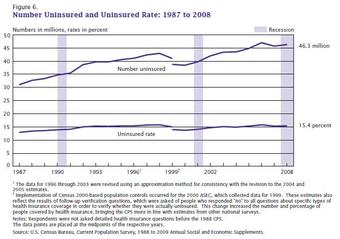
Uninsured and Uninsured Rate (1987 to 2008)
This image depicts the number of uninsured Americans and the uninsured rate from 1987 to 2008.
Some analysts have argued that the insurance premium structure may shift more costs onto younger and healthier people. Approximately $43 billion was spent in 2008 providing non-reimbursed emergency services for the uninsured, which the Act’s supporters argued increased the average family’s insurance premiums. Other studies claim the opposite that the argument for reduced ER visits has been shown to be largely a canard […] insuring the uninsured will lead to, very approximately, a doubling of health expenditures for the currently uninsured. The studies suggest that making insurance mandatory rather than voluntary will tend to bring younger, healthier people into the insurance pool, shifting the cost of the Act’s increased spending onto them.
15.2.5: Public Health
The role of public health is to improve the quality of society by protecting people from disease.
Learning Objective
Categorize the institutions responsible for public health and good governance
Key Points
- The dramatic increase in the average life span during the 20th century is widely credited to public health achievements, such as vaccination programs and control of many infectious diseases.
- One of the major sources of the increase in average life span in the early 20th century was the decline in the urban penalty brought on by improvements in sanitation. These improvements included chlorination of drinking water, filtration, and sewage treatment.
- Public health plays an important role in disease prevention efforts in both the developing world and in developed countries, through local health systems and non-governmental organizations.
Key Term
- epidemiological
-
Of or pertaining to epidemiology, the branch of a science dealing with the spread and control of diseases, computer viruses, concepts etc. throughout populations or systems.
Example
- In the United States, the front line of public health initiatives is state and local health departments. The United States Public Health Service (PHS), led by the Surgeon General of the United States, and the Centers for Disease Control and Prevention, headquartered in Atlanta, are involved with several international health activities in addition to their national duties.
Background
The dramatic increase in the average life span during the 20th century is widely credited to public health achievements, such as vaccination programs and control of many infectious diseases including polio, diphtheria, yellow fever, and smallpox; effective health and safety policies such as road traffic safety and occupational safety; improved family planning; tobacco control measures; and programs designed to decrease non-communicable diseases by acting on known risk factors such as a person’s background, lifestyle and environment.
One of the major sources of the increase in average life span in the early 20th century was the decline in the urban penalty brought on by improvements in sanitation. These improvements included chlorination of drinking water, filtration, and sewage treatment, which led to the decline in deaths caused by infectious waterborne diseases such as cholera and intestinal diseases. Cutler and Miller in “The Role of Public Health Improvements in Health Advances” demonstrate how typhoid fever deaths in Chicago, Baltimore, Cincinnati, and Cleveland declined after these American cities adopted chlorination, filtration, and sewage treatment.
Since the 1980s, the growing field of population health has broadened the focus of public health from individual behaviors and risk factors to population-level issues such as inequality, poverty, and education. Modern public health is often concerned with addressing determinants of health across a population. There is recognition that our health is affected by many factors including where we live, genetics, income, education and social relationships – these are known as the social determinants of health. A social gradient in health runs through society, with those who are poorest generally suffering poor health. However even those in the middle classes will generally have poorer health than those of a higher social stratum. Newer public health policies seeks to address these health inequalities by advocating for population-based policies that improve health in an equitable manner.
Additionally, with the onset of the epidemiological transition and as the prevalence of infectious diseases decreased through the 20th century, the focus of public health has recently turned to chronic diseases such as cancer and heart disease.
Public Health and the Government
Public health plays an important role in disease prevention efforts in both the developing world and in developed countries, through local health systems and non-governmental organizations. The World Health Organization (WHO) is the international agency that coordinates and acts on global public health issues. Most countries have their own government public health agencies , sometimes known as ministries of health, to respond to domestic health issues. For example in the United States, the front line of public health initiatives is state and local health departments. The United States Public Health Service (PHS), led by the Surgeon General of the United States, and the Centers for Disease Control and Prevention, headquartered in Atlanta, are involved with several international health activities, in addition to their national duties. In Canada, the Public Health Agency of Canada is the national agency responsible for public health, emergency preparedness and response, and infectious and chronic disease control and prevention. The public health system in India is managed by the Ministry of Health & Family Welfare of the government of India with state owned health care facilities.
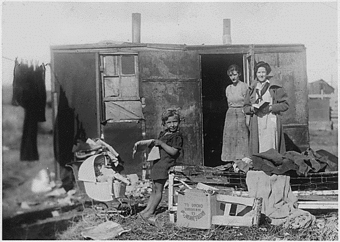
Public Health Nursing
Public health nursing made available through child welfare services.
15.3: Energy and Environmental Policy
15.3.1: Energy Policy
The energy policy of the United States is determined by federal, state, and local entities in the United States.
Learning Objective
Summarize the key provisions of a “cap-and-trade” approach to pollution reduction
Key Points
- Energy policy may include legislation, international treaties, subsidies and incentives to investment, guidelines for energy conservation, taxation, and other public policy techniques.
- The United States had resisted endorsing the Kyoto Protocol, preferring to let the market drive CO2 reductions to mitigate global warming, which will require CO2 emission taxation.
- The administration of Barack Obama has proposed an aggressive energy policy reform, including the need for a reduction of CO2 emissions with a cap and trade program, which could help encourage more clean renewable, sustainable energy development.
- The United States receives approximately 84% of its energy from fossil fuels. This energy is used for transport, industry, and domestic use. The remaining portion comes primarily from hydroelectric and nuclear stations.
- Renewable energy accounted for about 8% of total energy consumption in the United States in 2009. In the same year, approximately 10% of the electricity produced nationally came from renewable sources.
- Cap-and-trade is a market-based approach used to control pollution by providing economic incentives for achieving reductions in the emissions of pollutants.
Key Terms
- Renewable
-
A resource that is able to reproduce itself through biological and natural methods over time.
- Kyoto Protocol
-
The Kyoto Protocol is a protocol to the United Nations Framework Convention on Climate Change (UNFCCC or FCCC) that set binding obligations on the industrialized countries to reduce their emissions of greenhouse gases.
Example
- The 2010 United States federal budget proposes to support clean energy development with a 10-year investment of US $15 billion per year, generated from the sale of greenhouse gas (GHG) emissions credits. Under the proposed cap-and-trade program, all GHG emissions credits would be auctioned off, generating an estimated $78.7 billion in additional revenue in FY 2012, steadily increasing to $83 billion by FY 2019.
Background
The energy policy of the United States is determined by federal, state, and local entities in the United States, which address issues of energy production, distribution, and consumption, such as building codes and gas mileage standards. Energy policy may include legislation, international treaties, subsidies and incentives to investment, guidelines for energy conservation, taxation, and other public policy techniques. Global warming is the rise in the average temperature of Earth’s atmosphere and oceans since the late 19th century and its projected continuation. Since the early 20th century, Earth’s mean surface temperature has increased by about 0.8 °C (1.4 °F), with about two-thirds of the increase occurring since 1980. Warming of the climate system is unequivocal, and scientists are more than 90% certain that it is primarily caused by increasing concentrations of greenhouse gases produced by human activities such as the burning of fossil fuels and deforestation. These findings are recognized by the national science academies of all major industrialized nations.
State-specific energy-efficiency incentive programs also play a significant role in the overall energy policy of the United States. The United States had resisted endorsing the Kyoto Protocol, preferring to let the market drive CO2 reductions to mitigate global warming, which will require CO2 emission taxation . The administration of Barack Obama has proposed an aggressive energy policy reform, including the need for a reduction of CO2 emissions with a cap and trade program, which could help encourage more clean renewable, sustainable energy development.

Diagram of Greenhouse Effect
This diagram shows how the greenhouse effect works. Incoming solar radiation to the Earth equals 341 watts per square meter (Trenberth et al., 2009). Some of the solar radiation is reflected back from the Earth by clouds, the atmosphere, and the Earth’s surface (102 watts per square meter). Some of the solar radiation passes through the atmosphere. About half of the solar radiation is absorbed by the Earth’s surface (161 watts per square meter). Solar radiation is converted to heat energy, causing the emission of longwave (infrared) radiation back to the atmosphere (396 watts per square meter). Some of the infrared radiation is absorbed an re-emitted by heat-trapping “greenhouse” gases in the atmosphere. Outgoing infrared radiation from the Earth equals 239 watts per square meter.
Energy Independence
The 1973 oil crisis made energy a popular topic of discussion in the US. The Federal Department of Energy was started with steps planned toward energy conservation and more modern energy producers. A National Maximum Speed Limit of 55 mph (88 km/h) was imposed to help reduce consumption, and Corporate Average Fuel Economy (aka CAFE) standards were enacted to downsize automobile categories. Year-round Daylight Saving Time was imposed, the United States Strategic Petroleum Reserve was created, and the National Energy Act of 1978 was introduced. These initiatives resulted in alternate forms of energy and a diversified oil supply.
The United States receives approximately 84% of its energy from fossil fuels . This energy is used for transport, industry, and domestic use. The remaining portion comes primarily from hydroelectric and nuclear stations. Americans constitute less than 5% of the world’s population, but consume 26% of the world’s energy to produce 26% of the world’s industrial output. They account for about 25% of the world’s petroleum consumption, while producing only 6% of the world’s annual petroleum supply.

Coal
It was estimated by the Energy Information Administration that in 2007 primary sources of energy consisted of petroleum (36.0%), coal (27.4%), and natural gas (23.0%), amounting to an 86.4% share for fossil fuels in primary energy consumption in the world.
Cap-and-Trade
Cap-and-trade is a market-based approach used to control pollution by providing economic incentives for achieving reductions in the emissions of pollutants. A central authority (usually a governmental body) sets a limit or cap on the amount of a pollutant that may be emitted. The limit or cap is allocated or sold to firms in the form of emissions permits which represent the right to emit or discharge a specific volume of the specified pollutant. Firms are required to hold a number of permits (or allowances or carbon credits) equivalent to their emissions. The total number of permits cannot exceed the cap, limiting total emissions to that level. Firms that need to increase their volume of emissions must buy permits from other firms.
The transfer of permits is referred to as a trade. In effect, the buyer is paying a charge for polluting, while the seller is being rewarded for having reduced emissions. Thus, in theory, those who can reduce emissions most cheaply will do so, achieving the pollution reduction at the lowest cost to society. The 2010 United States federal budget proposes to support clean energy development with a 10-year investment of US $15 billion per year, generated from the sale of greenhouse gas (GHG) emissions credits. Under the proposed cap-and-trade program, all GHG emissions credits would be auctioned off, generating an estimated $78.7 billion in additional revenue in FY 2012, steadily increasing to $83 billion by FY 2019.
Renewable Energy
Renewable energy accounted for about 8% of total energy consumption in the United States in 2009. In the same year, approximately 10% of the electricity produced nationally came from renewable sources. The United States’ hydroelectric plants make the largest contribution to the country’s renewable energy, producing 248,100MW of the 371,700MW (67%) generated through all renewable energy. However, wind power in the United States is a growing industry. Increases in wind, solar, and geothermal power are expected to allow renewable energy production to double in the three-year period from 2009 to 2012, an increase from 8% to 14% of total consumption. Most of the increase is expected to come from wind power.

Green Mountain Wind Farm, Fluvanna 2004
The Brazos Wind Farm, also known as the Green Mountain Energy Wind Farm, near Fluvanna, Texas. Note cattle grazing beneath the turbines.
15.3.2: Environmental Policy
Environmental Policy has become highly contentious and political, with competing interests involved at any legislation over the environment.
Learning Objective
Describe the key conflict in environmental policy
Key Points
- The environment covers so many different aspects of life from health and recreation to business and commerce that that there are always competing interests involved an any legislation over the environment.
- Many individuals and organizations are involved as stakeholders in the process of making and implementing environmental policy.
- One of the enduring conflicts in environmental policy is between environmental and business interests. There is often a sense that the regulations or limitations made for environmental protection will limit economic growth.
- However, some groups are attempting to incorporate concern for the environment with business and innovation.
- U.S. environmental policy is always international policy as well. For example, when the U.S. pulled out of its obligations under the Kyoto Accord there was a great deal of international criticism.
Key Terms
- Kyoto Protocol
-
The Kyoto Protocol is a protocol to the United Nations Framework Convention on Climate Change (UNFCCC or FCCC) that set binding obligations on the industrialized countries to reduce their emissions of greenhouse gases.
- environmental policy
-
any course of action deliberately taken or not taken to manage human activities with a view to prevent, reduce, or mitigate harmful effects on nature and natural resources
Environmental Policy
Environmental policy in the U.S. has become highly contentious, competitive, and political. The environment covers so many different aspects of life from health and recreation to business and commerce that there are always competing interests involved at any legislation focused on the environment.
Additionally, many individuals and organizations are involved as stakeholders in the process of making and implementing environmental policy. These include various members of the executive and legislative branches of government, state and municipal governments, as well as civil servants, external interests groups, and international governments and residents. Within the Federal government alone there are the Environmental Protections Agency , the Department of Transportation, and the U.S. Fish and Wildlife Agency.
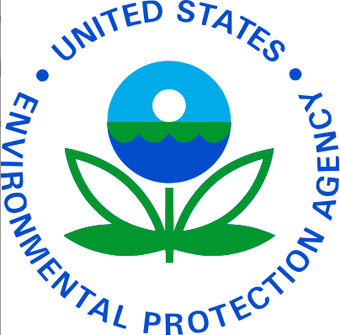
Environmental Protection Agency
The EPA is just one of the various bureaus involved in U.S. environmental policy.
Various legislation governs environmental concerns in the U.S., including the National Environmental Policy Act (NEPA) which was first introduced in 1970. This act mandates the preparation of Environmental Assessments and Environmental Impact Statements to try and limit the environmental damage of development.
One of the enduring conflicts in environmental policy is between environmental and business interests. There is often a sense that the regulations or limitations made for environmental protection will limit economic growth. However, some groups are attempting to incorporate concerns for the environment, with business and innovation. For example, the Bright Green environmental movement focuses on developing technological fixes for environmental problems. The Green Jobs movement focuses on combining needed new employment opportunities in low-income neighborhoods and neighborhoods of color with environment improvements in those same neighborhoods.
Finally, because the U.S. has to share the Earth with all of the other countries, U.S. environmental policy is always international policy as well. For example, when the U.S. pulled out of its obligations under the Kyoto Protocol there was a great deal of international criticism.
15.3.3: Oil
Oil remains a major energy source in the U.S., and changing this reliance requires political initiative.
Learning Objective
Describe the key impediments to severing a dependence on fossil fuels
Key Points
- In the 1970s, politicians began considering the importance of the U.S. becoming less dependent on foreign-produced oil.
- However, fossil fuels and petroleum remain a major energy source in the U.S.. This is in part because of the strength of the oil and energy lobby.
- Two concerns over the influence of oil companies on energy policy are ongoing environmental consequences and political impact.
- Today the idea of energy independence has emerged as an important political buzzword. It is yet to be seen if there is enough political will to make a significant shift from oil to other energy sources.
Key Term
- energy independence
-
Energy independence involves reducing U.S. imports of oil and other foreign sources of energy. If total energy is considered, the U.S. is over 70% self-sufficient.
Oil
In the 1970s, the U.S. faced an oil crisis, with severe shortages leaving lineups at gas stations across the country . The crisis was set off at least in part because of oil embargoes levied by OAPEC (Organization of Arab Petroleum Exporting Countries), and conflicts in Libya. The oil crisis contributed to recessions in the country. At that time, politicians in the U.S. began considering the importance of becoming less dependent on foreign-produced oil.

1973 Oil Crisis
During the 1970s there were oil shortages in the US. This sign outside of a gas station let patrons know the state of their supply.
However, fossil fuels and petroleum remain a major energy source in the U.S.. This is in part because of the strength of the oil and energy lobby in the US. In the 2006 election cycle, oil companies donated $19 million dollars to campaigns with over 80% of that going to Republican candidates. There have also been concerns that oil lobbyists have had direct influence through close relationships with politicians. For example, oil executives were invited to consult on issues such as the U.S. position on the Kyoto Protocol and the involvement in Iraq.
Two concerns over the influence of oil companies on energy policy are ongoing environmental consequences and the political impacts of a reliance on oil. The continuing influence of oil companies has been implicated in limiting the development of new energy resources and technologies. The film “Who Killed the Electric Car? “, for example, looks at the various factors that limited the production and success of the electric car. The movie examines the role of oil companies, and particularly the Western States Petroleum Association, in limiting the production of public car charging stations.
Today the idea of energy independence has emerged as an important political buzzword. It is yet to be seen if there is enough political will to make a significant shift from oil to other energy sources.
15.3.4: Climate Change
Global warming policy can be quite contentious because competing interests get involved in the policy-making and implementation process.
Learning Objective
Analyze the difficulties confronting cooperative international action on climate
Key Points
- Global warming, or climate change, is the idea that the actions of human beings are drastically changing weather patterns on the planet, including the temperature.
- Most scientists agree that the Earth has warmed significantly in recent years. They are quite confident about the human influence on change. However, there is disagreement about what to do about global warming.
- While 191 countries had ratified the Kyoto Protocol by September 2011, the U.S. was not one of them.
- Another idea for slowing down carbon emissions is a cap-and-trade system. As a market-based system, it would see limits or caps set on the mount of greenhouse gases that could be emitted.
- As with all environmental policy, global warming policy can be quite contentious because competing interests get involved in the policy-making and implementation process.
Key Terms
- anthropogenic
-
Having its origin in the influence of human activity on nature.
- global warming
-
he sustained increase in the average temperature of the earth, sufficient to cause climate change
- cap-and-trade
-
Cap-and-trade is a market-based approach used to control pollution by providing economic incentives for achieving reductions in the emissions of pollutants.
- Kyoto Protocol
-
The Kyoto Protocol is a protocol to the United Nations Framework Convention on Climate Change (UNFCCC or FCCC) that set binding obligations on the industrialized countries to reduce their emissions of greenhouse gases.
Global Warming
Global warming, or climate change, is the idea that the actions of human beings are drastically changing weather patterns on the planet, including the temperature. Most scientists agree that the Earth has warmed significantly in recent years. The warming is particularly true around the poles . This is causing polar icecap melting and a degradation of the protective ozone layer. Most scientists are also confident about the anthropogenic drivers of climate change. However, there is a great deal of division over the question of how important these changes are and what should be done about it.

Arctic Wildlife
Global warming is disproportionately affecting the polar regions, and changing the landscape for arctic wildlife like the polar bear.
One of the key problems is that the immediate effects of climate change are likely to be felt by counties with less political and economic clout. These include many countries in the global south and island nations that will be impacted if the sea levels rise.
One aspect that has been identified as important in slowing down climate change is the reduction in greenhouse gases, also referred to as carbon emissions.
Because of the global impact of these emissions, international treaties have tried to address the issue. The Kyoto Protocol was one such treaty, first introduced in Kyoto, Japan in 2005. While 191 countries had ratified the agreement by September 2011, the U.S. was not one of them.
Another idea for slowing down carbon emissions is a cap-and-trade system. This is a market-based system that would see limits, or caps, set on the amount of greenhouse gasses that could be emitted. Companies would purchase permits for a certain level of emissions. A market for these permits would be created so companies that produced lower levels could trade their permits with companies that wished to pollute at a higher rate.
As with all environmental policy, global warming policies can be quite contentious because competing interests get involved in the policy-making and implementation process. One difficulty is that the process has become highly politicized. Republican politicians often questioning the science behind climate change. Add to that the difficulty that is caused by highly influential business lobby groups, and it becomes apparent why it is so difficult to pass legislation to try and slow climate change.
15.3.5: New Sources of Energy
There are many concerns about the environmental and political impact of continued dependence on nonrenewable, foreign-produced fossil fuels.
Learning Objective
Describe the challenges facing those attempting to shift the United States away from non-renewable sources of energy
Key Points
- There are many concerns about the environmental and political impact of a continued dependance on non-renewable fossil fuels, particularly fossil fuels from sources outside of the U.S.
- Energy independence has become an important buzzword in U.S. politics. Investment in new and alternative sources of energy has also increased in recent years.
- The cooperation of various stakeholders is necessary to make new sources of fuel successful. These stakeholders include interest groups, politicians and consumers.
Key Term
- energy independence
-
Energy independence involves reducing U.S. imports of oil and other foreign sources of energy. If total energy is considered, the U.S. is over 70% self-sufficient.
New Sources of Energy
Environmental and political stability in the U.S. has been threatened in recent years by a continued dependence on non-renewable fossil fuels, particularly those from outside sources. “Energy independence” has thus become an important buzzword in U.S. politics, leading to greater investment in new and alternative sources of energy.
However, the widespread use of alternative fuel requires more than just scientific research. Investment in new technology is also affected by the influence of various interest groups, including representatives of traditional fuel suppliers who may have a vested interest in slowing the development of alternatives. Shifting to alternative fuels would also require strong legislative and regulations-based support in order to jump-start and sustain production. Finally, it would require a willingness on the part of consumers to make the shift away from the energy sources they have grown accustomed to.
While there are many alternative energy sources to choose from, none of them is perfect, and each has its own supporters and detractors.
Two of the best known and least scientifically controversial new energy sources are solar power and wind power. Both involve harnessing the power of naturally occurring events– sunlight and wind– and converting them into electric power through solar panels or wind turbines .

Wind Farm
These wind turbines exemplify one type of a new and alternative energy source.
Critics of these sources often cite aesthetic concerns– for example, that the panels of turbine farms block site-lines or alter landscape and architecture. Particularly in the case of wind farms, there is often extensive community consultation prior to construction in order to address potential aesthetic and environmental impacts.
Other alternatives include biofuels such as ethanol and clean coal technologies. In the U.S., ethanol is produced mainly from corn. Ethanol fuels burn more cleanly than traditional fuels; however, there is some concern that the production of large amounts of corn exclusively for biofuels could be detrimental to farm lands. The idea of clean coal is still largely experimental, but the Department of Energy is investing large sums in research and technology development in this area. The incentive is that clean coal would release less carbon, and that other energy sources such as hydrogen could also be captured for use in the process.
This is not the first time the idea of greater energy independence has become popular in U.S. policy and politics. For example, during the Oil Embargo of the 1970s, U.S. politicians began to discuss alternatives to fossil fuels. It remains to be seen whether there is sufficient political will this time around to make a significant shift towards alternative fuels.
15.4: Education Policy
15.4.1: Education Policy
Education policy refers to the collection of laws and rules that govern the operation of education systems.
Learning Objective
Discuss the institutions and issues relevant to current education policy in the United States and the sources of education policy evaluation and analysis
Key Points
- Examples of areas subject to debate in education policy include school size, class size, school choice, school privatization, teaching methods, curricular content, and graduation requirements.
- Unlike the systems of most other countries, education in the United States is highly decentralized, and the federal government and Department of Education are not heavily involved in determining curricula or educational standards (with the recent exception of the No Child Left Behind Act).
Key Terms
- Department of Education
-
The Department of Education is a Cabinet-level department of the United States government. The primary functions of the Department of Education are to “establish policy for, administer and coordinate -most federal assistance to education, collect data on US schools, and to enforce federal educational laws regarding privacy and civil rights. “
- Education policy
-
the principles and government policy-making in the educational sphere, as well as the collection of laws and rules that govern the operation of education systems
- Education policy
-
Education policy refers to the collection of laws and rules that govern the operation of education systems.
Education Policy
Education policy refers to the collection of laws and rules that govern the operation of education systems.
Education occurs in many forms for many purposes. Examples include early childhood education, kindergarten through to 12th grade, two and four year colleges or universities, graduate and professional education, adult education and job training. Therefore, education policy can directly affect the education of people at all ages.
Examples of areas subject to debate in education policy, include school size, class size, school choice, school privatization, tracking, teacher education and certification, teacher pay, teaching methods, curricular content, graduation requirements, school infrastructure investment, and the values that schools are expected to uphold and model.
Education policy analysis is the scholarly study of education policy. It seeks to answer questions about the purpose of education, the objectives (societal and personal) that it is designed to attain, the methods for attaining them and the tools for measuring their success or failure. Research intended to inform education policy is carried out in a wide variety of institutions and in many academic disciplines. Important researchers are affiliated with departments of psychology , economics , sociology , and human development , in addition to schools and departments of education or public policy.
The Department of Education
The federal department relating responsible for education oversight is the Department of Education . The Department of Education is a Cabinet-level department of the United States government. The primary functions of the Department of Education are to “establish policy for, administer and coordinate -most federal assistance to education, collect data on US schools, and to enforce federal educational laws regarding privacy and civil rights. ” However, the Department of Education does not establish schools or colleges.
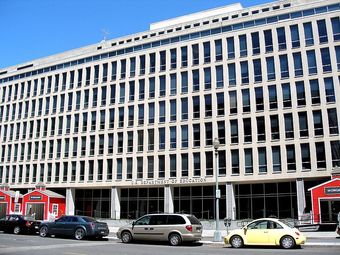
U. S. Department of Education
The Lyndon B. Johnson Department of Education Building
Unlike the systems of most other countries, education in the United States is highly decentralized, and the federal government and Department of Education are not heavily involved in determining curricula or educational standards (with the recent exception of the No Child Left Behind Act). This has been left to state and local school districts. The quality of educational institutions and their degrees is maintained through an informal private process known as accreditation, over which the Department of Education has no direct public jurisdictional control.
The Department’s mission is: to promote student achievement and preparation for global competitiveness by fostering educational excellence and ensuring equal access. Aligned with this mission of ensuring equal access to education, the Department of Education is a member of the United States Interagency Council on Homelessness, and works with federal partners to ensure proper education for homeless and runaway youth in the United States.
15.4.2: Current Challenges for Education
Some challenges in education include curriculum unification, racial achievement gap, and controversy over sex education and affirmative action.
Learning Objective
Identify the most pressing issues in education curriculum and control
Key Points
- There is no unified curriculum in the United States. Not only do schools offer a range of topics and quality, but private schools may include mandatory religious classes.
- In 2003 a Supreme Court decision concerning affirmative action in universities allowed educational institutions to consider race as a factor in admitting students, but ruled that strict point systems are unconstitutional.
- Almost all students in the U.S. receive some form of sex education between grades 7 and 12; many schools begin addressing some topics as early as grades 4 or 5. However, what students learn varies widely, because curriculum decisions are so decentralized.
Key Term
- Racial Achievement Gap
-
The Racial Achievement Gap in the United States refers to the educational disparities between minority students and Caucasian students.
Contemporary Education Issues
Major educational issues in the United States center on curriculum and control. One of the major controversies of the United States education policy is the No Child Left Behind Act which will be covered in its own section.
Curriculum issues
There is no unified curriculum in the United States. Not only do schools offer a range of topics and quality, but private schools may include mandatory religious classes. These religious aspects raise the question of government funding school vouchers in states with Blaine Amendments in their constitution. This has produced debate over the standardization of curricula. Additionally, there is debate over which subjects should receive the most focus, with astronomy and geography among those cited as not being taught enough in schools.
Attainment
Drop-out rates are a concern in American four year colleges. In New York, 54 percent of students entering four-year colleges in 1997 had a degree six years later — and even less among Hispanics and African-Americans. Since the 1980s the number of educated Americans has continued to grow, but at a slower rate. Some have attributed this to an increase in the foreign born portion of the workforce. However, the decreasing growth of the educational workforce has instead been primarily due to slowing down in educational attainment of people schooled in the United States .
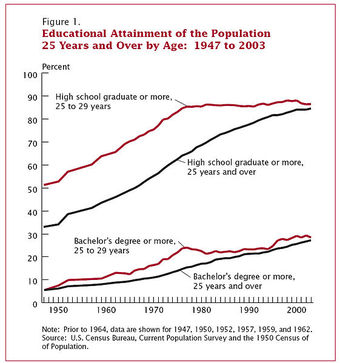
Educational Attainment Since 1947
This graph shows the educational attainment from 1947 to 2003 in the United States.
Racial Achievement Gap
The Racial Achievement Gap in the United States refers to the educational disparities between minority students and Caucasian students. This disparity manifests itself in a variety of ways: African-American and Hispanic students are more likely to receive lower grades, score lower on standardized tests, drop out of high school, and are less likely to enter and complete college.
Evolution in Kansas
In 1999 the School Board of the state of Kansas caused controversy when it decided to eliminate teaching of evolution in its state assessment tests. Scientists from around the country demurred. Many religious and family values groups, on the other hand, claimed that evolution is simply a theory in the colloquial sense, and as such creationist ideas should therefore be taught alongside it as an alternative viewpoint. A majority of the Kansas population supported teaching intelligent design and/or creationism in public schools.
Sex education
Almost all students in the U.S. receive some form of sex education between grades 7 and 12; many schools begin addressing some topics as early as grades 4 or 5. However, what students learn varies widely, because curriculum decisions are so decentralized. Many states have laws governing what is taught in sex education classes or allowing parents to opt out. Some state laws leave curriculum decisions to individual school districts.
According to a 2004 survey, over 80% of polled parents agreed that the sex education was helpful while fewer than 17% stated their view that the sex education was inappropriate. 10 percent believed that their children’s sexual education class forced them to discuss sexual issues “too early. “
Textbook review and adoption
In many localities in the United States, the curriculum taught in public schools is influenced by the textbooks used by the teachers. In some states, textbooks are selected for all students at the state level. Since states such as California and Texas represent a considerable market for textbook publishers, these states can exert influence over the content of the books.
In 2010, the Texas Board of Education adopted new Social Studies standards that could potentially impact the content of textbooks purchased in other parts of the country. The deliberations that resulted in the new standards were partisan in nature and are said to reflect a conservative leaning in the view of United States history.
Affirmative action
In 2003 a Supreme Court decision concerning affirmative action in universities allowed educational institutions to consider race as a factor in admitting students, but ruled that strict point systems are unconstitutional. Opponents of racial affirmative action argue that the program actually benefits middle- and upper-class people of color at the expense of the lower class. Prominent African American academics Henry Louis Gates and Lani Guinier, while favoring affirmative action, have argued that in practice, it has led to recent black immigrants and their children being greatly overrepresented at elite institutions, at the expense of the historic African American community made up of descendants of slaves.
Control
There is some debate about where control for education actually lies. Education is not mentioned in the constitution of the United States. In the current situation, the state and national governments have a power-sharing arrangement, with the states exercising most of the control. The federal government uses the threat of decreased funding to enforce laws pertaining to education. Furthermore, within each state there are different types of control. Some states have a statewide school system, while others delegate power to county, city or township-level school boards.
15.4.3: The No Child Left Behind Act
The No Child Left Behind Act supports standards based education reform to set high standards and establish goals to improve education.
Learning Objective
Evaluate the arguments for and against the No Child Left Behind Act
Key Points
- The Act requires states to develop assessments in basic skills. States must give these assessments to all students at select grade levels in order to receive federal school funding. The standards in the act are set by each individual state.
- Schools receiving Title I funding must make Adequate Yearly Progress (AYP) in test scores; each year, its fifth graders must do better on standardized tests than the previous year’s fifth graders.
- Critics argue the focus on standardized testing as the means of assessment encourages teachers to teach a narrow subset of skills the teacher believes will increase test performance, rather than focus on acquiring deep understanding of the curriculum. This is referred to as teaching to the test.
Key Term
- No Child Left Behind Act
-
The No Child Left Behind Act of 2001 (NCLB) is a United States Act of Congress that is a reauthorization of the Elementary and Secondary Education Act, which included Title I, the government’s flagship aid program for disadvantaged students. NCLB supports standards-based education reform based on the premise that setting high standards and establishing measurable goals can improve individual outcomes in education.
No Child Left Behind Act
The No Child Left Behind Act of 2001 (NCLB) is a United States Act of Congress that is a reauthorization of the Elementary and Secondary Education Act, which included Title I, the government’s flagship aid program for disadvantaged students. NCLB supports standards-based education reform based on the premise that setting high standards and establishing measurable goals can improve individual outcomes in education. The Act requires states to develop assessments in basic skills. States must give these assessments to all students at select grade levels in order to receive federal school funding. The standards in the act are set by each individual state. NCLB expanded the federal role in public education through annual testing, annual academic progress, report cards, teacher qualifications, and funding changes. The bill passed in the U.S. Congress with bipartisan support. President Bush signed it into law on January 8, 2002 .
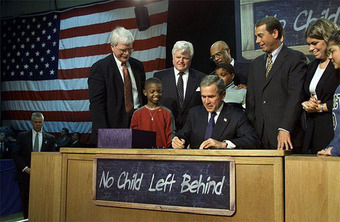
The Signing of the No Child Left Behind Act
President Bush signs the No Child Left Behind Act January 8th, 2002.
Provisions of the Act
Schools receiving Title I funding through the Elementary and Secondary Education Act of 1965 must make Adequate Yearly Progress (AYP) in test scores (each year, its fifth graders must do better on standardized tests than the previous year’s fifth graders). If the school’s results are repeatedly poor, then steps are taken to improve the school.
Schools that miss AYP for a second consecutive year are labeled as being “in need of improvement” and are required to develop a two-year improvement plan for the trouble subject. Students are given the option to transfer to a better school within the school district, if any exists. Missing AYP in the third year forces the school to offer free tutoring and other supplemental education services to struggling students. If a school misses its AYP target for a fourth consecutive year, the school is labeled as requiring “corrective action,” which may involve wholesale replacement of staff, introduction of a new curriculum, or extending the amount of time students spend in class. A fifth year of failure results in planning to restructure the school; the plan is implemented if the school fails to hit its AYP targets for the sixth year in a row. Common options include closing the school, turning the school into a charter school, hiring a private company to run the school, or asking the state office of education to run the school directly.
The act also requires schools to let military recruiters have students’ contact information and other access to the student, if the school provides that information to universities or employers, unless the students opt out of giving military recruiters access.
Increased accountability
Supporters of the NCLB claim one of the strong positive points of the bill is the increased accountability that is required of schools and teachers. The yearly standardized tests are the main means of determining whether schools are living up to the standards that they are required to meet. If the required improvements are not made, the schools face decreased funding and other punishments that contribute to the increased accountability. According to supporters, these goals help teachers and schools realize the significance and importance of the educational system and how it affects the nation. Opponents of this law say that the punishments hurt the schools and do not contribute to the improvement of student education.
Additionally, the Act provides information for parents by requiring states and school districts to give parents detailed report cards on schools and districts explaining the school’s AYP performance. Schools must also inform parents when their child is being taught by a teacher or para-professional who does not meet “highly qualified” requirements.
Criticisms of standardized testing under NCLB
Critics have argued that the focus on standardized testing as the means of assessment encourages teachers to teach a narrow subset of skills that the teacher believes will increase test performance, rather than focus on acquiring deep understanding of the full, broad curriculum. This is colloquially referred to as “teaching to the test. “
Under No Child Left Behind, schools were held almost exclusively accountable for absolute levels of student performance. This means even schools that were making great strides with students were still labeled as “failing” just because the students had not yet made it to a “proficient” level of achievement.
The incentives for improvement also may cause states to lower their official standards. A 2007 study by the U.S. Dept. of Education indicates that the observed differences in states’ reported scores is largely due to differences in the stringency of their standards.
“Gaming” the system
The system of incentives and penalties sets up a strong motivation for schools, districts and states to manipulate test results. For example, schools have been shown to employ “creative reclassification” of drop-outs to reduce unfavorable statistics. Critics argue that these and other strategies create an inflated perception of NCLB’s successes, particularly in states with high minority populations.
15.5: Immigration Policy
15.5.1: Immigration Policy
Immigration reform refers to changes in government policies that attempt to either promote or curb immigration.
Learning Objective
Identify key pieces of legislation that shaped immigration policy in the U.S.
Key Points
- Proponents of greater immigration enforcement argue that illegal immigrants cost taxpayers an estimated $338.3 billion dollars and jeopardize the safety of law enforcement officials and citizens, especially along the Mexican border.
- The Immigration Reform and Control Act of 1986 made it illegal to hire or recruit illegal immigrants. In 2006, the House of Representatives passed the Border Protection, Anti-terrorism and Illegal Immigration Control Act and the Senate passed the Comprehensive Immigration Reform Act.
- In 2010, Governor of Arizona Jan Brewer signed the Support Our Law Enforcement and Safe Neighborhoods Act. The law directs law enforcement officials to ask for immigration papers on a reasonable suspicion that a person might be an illegal immigrant and make arrests for not carrying ID papers.
Key Terms
- amnesty
-
An act of the sovereign power granting oblivion, or a general pardon, for a past offense, as to subjects concerned in an insurrection.
- bipartisan
-
relating to, or supported by two groups, especially by two political parties
Background
In 1924 Congress passed the Immigration Act of 1924, which favored source countries that already had many immigrants in the U.S. and excluded immigrants from unpopular countries. Immigration patterns of the 1930s were dominated by the Great Depression, and in the early 1930s, more people emigrated from the United States than immigrated to it. Immigration continued to fall throughout the 1940s and 1950s, but it increased again afterwards.
Immigration is also widely used to describe proposals to increase legal immigration while decreasing illegal immigration, such as the guest worker proposal supported by George W. Bush. Proponents of greater immigration enforcement argue that illegal immigrants cost taxpayers an estimated $338.3 billion dollars and jeopardize the safety of law enforcement officials and citizens, especially along the Mexican border.
The Immigration Reform and Control Act of 1986 made it illegal to hire or recruit illegal immigrants. In 2006, the House of Representatives passed the Border Protection, Anti-terrorism and Illegal Immigration Control Act of 2005, and in 2006 the U.S. Senate passed the Comprehensive Immigration Reform Act of 2006. Neither bill became law because their differences could not be reconciled.
The Immigration and Nationality Act Amendments of 1965 (the Hart-Cellar Act) abolished the national origins quota system that had been put in place by the 1924 Immigration Act. In 2006, the number of immigrants totaled a record 37.5 million. After 2000, immigration to the United States numbered approximately 1,000,000 per year. Despite tougher border security after 9/11, nearly 8 million immigrants came to the United States from 2000 to 2005–more than in any other five-year period in the nation’s history. Almost half entered illegally. In 2006, 1.27 million immigrants were granted legal residence.
Recent Immigration Reform Hot Topics
In 2009 immigration reform became a hot topic, since the Obama administration recently signaled interest in beginning a discussion on comprehensive immigration reform before the year’s end. The proposed reform plan had as its goal bipartisan support and included six sections designed to appeal to both parties. These six sections are: (1) fixing border enforcement, (2) fixing interior enforcement, such as preventing visa overstays, (3) preventing people from working without a work permit, (4) creating a committee to adapt the number of visas available to changing economic times, (5) an amnesty type of program to legalize undocumented immigrants, and (6) programs to help immigrants adjust to life in the United States.
Citing Congress’ failure to enforce U.S. immigration laws, the state of Arizona confronted reform and on April, 23, 2010 Republican Governor Jan Brewer signed the Support Our Law Enforcement and Safe Neighborhoods Act, the broadest and strictest immigration reform imposed in the United States. The Arizona immigration law directs law enforcement officials to ask for immigration papers on a reasonable suspicion that a person might be an illegal immigrant and make arrests for not carrying ID papers. On July 6, 2010, the U.S. Department of Justice filed suit against Arizona with the intent of preventing Arizona from enforcing the law. In June 2012, the U.S. Supreme Court ruled on the case Arizona v. United States, upholding the provision requiring immigration status checks during law enforcement stops but striking down three other provisions as violations of the Supremacy Clause of the United States Constitution.
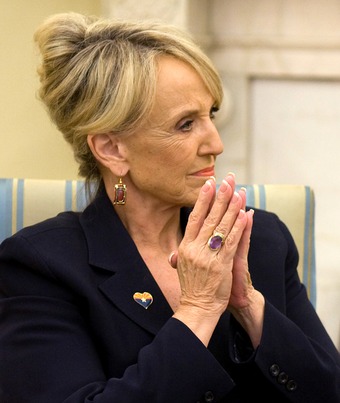
Jan Brewer
Jan Brewer, Governor of Arizona, who signed the controversial Suppor Our Law Enforcement and Safe Neighborhoods Act, which makes it a state misdemeanor crime for an immigrant to be in Arizona without carrying registration documents required by federal law.
Being the first state to pass such legislation, Arizona has set a precedent for other states. Although the response has cost the state between $7 million and $52 million, some in the state still feel that this outcome will outweigh the initial cost. Due to conflict and protest, Governor Brewer signed the Arizona House Bill 2162 (HB 2162) amending text in the original document. HB 2162 includes that race, color, and national origin would not play a role in prosecution; in order to investigate an individual’s immigration status, he or she must be “lawfully stopped, arrested, or detained. “
In the absence of comprehensive immigration reform at the federal level, many advocacy groups have focused on improving the fairness and efficiency of the immigration court system. They propose incremental steps the executive branch can take to stop an assembly line approach to deportation proceedings. These groups have identified several issues that threaten the due process rights of immigrants, including reliance on low quality videoconferencing to conduct hearings, inadequate language interpretation services for non-English speakers, and limited access to court records.
15.5.2: Illegal Immigration
Unauthorized immigration is when a non-citizen has entered the country without government permission and in violation of the law.
Learning Objective
Describe the nature and scope of illegal immigration in the United States
Key Points
- Between 7 million and 20 million illegal immigrants are estimated to be living in the United States. The majority of illegal immigrants are from Mexico.
- About 8 percent of children born in the United States in 2008 — about 340,000 — were offspring of unauthorized immigrants. These infants are, according to the Fourteenth Amendment to the Constitution, American citizens from birth.
- According to USA Today in 2006, about 4% work in farming; 21% have jobs in service industries. Substantial numbers can be found in construction and related occupations (19%), production, installation, and repair (15%), sales (12%), management (10%) and transportation (8%).
- A common means of border crossing is to hire professionals who smuggle illegal immigrants across the border for pay. Those operating on the US-Mexico border are known informally as coyotes.
Key Term
- coyote
-
A smuggler of illegal immigrants across the land border from Mexico into the United States of America.
An illegal immigrant in the United States is a non-citizen who has either entered the country without government permission and in violation of United States Nationality Law, or stayed beyond the termination date of a visa. Unauthorized immigration raises many political, economic and social issues and has become a source of major controversy. Illegal immigrants continue to outpace the number of legal immigrants—a trend that’s held steady since the 1990s. While the majority of illegal immigrants continue to concentrate in places with existing large Hispanic communities, illegal immigrants are increasingly settling throughout the rest of the country.
Between 7 million and 20 million illegal immigrants are estimated to be living in the United States. The majority of these illegal immigrants are from Mexico. An estimated 14 million people live in families in which the head of household or the spouse is an illegal immigrant. A quarter of all immigrants who have arrived in recent years have at least some college education. Nonetheless, illegal immigrants as a group tend to be less educated than other sections of the U.S. population: 49% haven’t completed high school, compared with 9% of native-born Americans and 25% of legal immigrants.
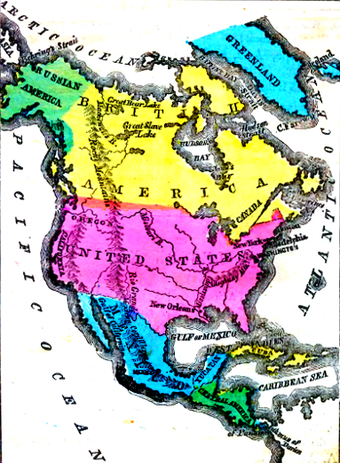
North America
Map of Mexico and United States border
The Pew Hispanic Center determined that according to an analysis of Census Bureau data about 8 percent of children born in the United States in 2008 — about 340,000 — were offspring of unauthorized immigrants. In total, 4 million U.S.-born children of unauthorized immigrant parents resided in this country in 2009. These infants are, according to the Fourteenth Amendment to the Constitution, American citizens from birth. These children are sometimes pejoratively referred to as anchor babies by those aggressively opposed to this method of citizenship attained outside of the legal immigration process. The majority of children that are born with illegal parents fail to graduate high school, averaging two fewer years of school than their peers. But once the parents do gain citizenship, the children do much better in school.
Illegal immigrants work in many sectors of the U.S. economy. According to USA Today in 2006, about 4% work in farming; 21% have jobs in service industries; and substantial numbers can be found in construction and related occupations (19%), and in production, installation and repair (15%), with 12% in sales, 10% in management and 8% in transportation. Illegal immigrants have lower incomes than both legal immigrants and native-born Americans, but earnings do increase somewhat the longer an individual is in the country.
There are an estimated half million illegal entries into the United States each year. A common means of border crossing is to hire professionals who smuggle illegal immigrants across the border for pay. Those operating on the US-Mexico border are known informally as coyotes. According to Pew, between 4 and 5.5 million unauthorized migrants entered the United States with a legal visa, accounting for between 33–50% of the total population. A tourist or traveler is considered a “visa overstay” once he or she remains in the United States after the time of admission has expired. Visa overstays tend to be somewhat more educated and better off financially than those who entered the country illegally. A smaller number of unauthorized migrants entered the United States legally using the Border Crossing Card, authorizing border crossings into the U.S. for a set amount of time. Border Crossing Card entry accounts for the vast majority of all registered non-immigrant entry into the United States – 148 million out of 179 million total – but there is little hard data as to how much of the illegal immigrant population entered in this way.
15.5.3: Immigration Reform
Immigration reform regards changes to current policy including promoted or open immigration, as well as reduced or eliminated immigration.
Learning Objective
Summarize recent legislative trends in immigration reform on the state and national level
Key Points
- Proponents of great immigration enforcement argue that illegal immigrants cost taxpayers an estimated $338.3 billion and jeopardize the safety of law enforcement officials and citizens, especially at the Mexican border.
- The Immigration Reform and Control Act of 1986 made it illegal to hire or recruit illegal immigrants.
- In 2006, the House of Representatives passed the Border Protection, Anti-terrorism and Illegal Immigration Control Act of 2005 and the Senate passed the Comprehensive Immigration Reform Act of 2006. Neither bill became a law.
- President Obama proposed to fix border enforcement, interior enforcement, prevent people from working without a work permit, create a committee to adapt the number of visas available to changing times, an amnesty program to legalize undocumented immigrants and programs to help immigrants adjust.
Key Terms
- deportation
-
The act of deporting or exiling, or the state of being deported; banishment; transportation.
- amnesty
-
An act of the sovereign power granting oblivion, or a general pardon, for a past offense, as to subjects concerned in an insurrection.
- bipartisan
-
relating to, or supported by two groups, especially by two political parties
Use of the Term
Immigration reform is a term used in political discussion regarding changes to current immigration policy. In its strict definition, reform means to change towards an improved form or condition by amending or removing faults or abuses. In the political sense, immigration reform may include promoted, expanded or open immigration. It may also include reduced or eliminated immigration. Immigration is also widely used to describe proposals to increase legal immigration while decreasing illegal immigration, such as the guest worker proposal supported by George W. Bush.
Legislative Trends
Illegal immigration is a controversial issue in the United States. Proponents of greater immigration enforcement argue that illegal immigrants cost taxpayers an estimated $338.3 billion dollars. They also argue that these immigrants jeopardize the safety of law enforcement officials and citizens, especially along the Mexican border.
The Immigration Reform and Control Act of 1986 made it illegal to hire or recruit illegal immigrants. The U.S. House of Representatives passed the Border Protection, Anti-terrorism and Illegal Immigration Control Act of 2005, and, in 2006, the U.S. Senate passed the Comprehensive Immigration Reform Act of 2006. Neither bill became law because their differences could not be reconciled in conference committee.
In 2009, immigration reform became a hot topic as the Obama administration signaled interest in beginning a discussion on comprehensive immigration reform. The proposed comprehensive immigration reform plan had as its goal bipartisan support. As such, it includes six sections designed to have something for everyone. These six sections are: (1) fixing border enforcement, (2) increasing interior enforcement, such as preventing visa overstays, (3) preventing people from working without a work permit, (4) creating a committee to adapt the number of visas available to changing economic times, (5) a type of amnesty program to legalize undocumented immigrants and (6) programs to help immigrants adjust to life in the United States.
The Case of Arizona
Citing Congress’ failure to enforce U.S. immigration laws, the state of Arizona confronted reform. In 2009, services provided to illegal immigrants, including incarceration, cost the state of Arizona an estimated $2.7 billion. On April, 23, 2010, Republican Governor Jan Brewer signed the Support Our Law Enforcement and Safe Neighborhoods Act, the broadest and strictest immigration reform imposed in the United States. The Arizona immigration law directs law enforcement officials to ask for immigration papers on a reasonable suspicion that a person might be an illegal immigrant. Officials can then arrest those not carrying ID papers. On July 6, 2010, the US Department of Justice filed suit against Arizona with the intent of preventing the state from enforcing the law and asks the court to find certain sections of the legislation null and void. Congress has left this issue untouched as many feared such a vote could threaten their chances at reelection.
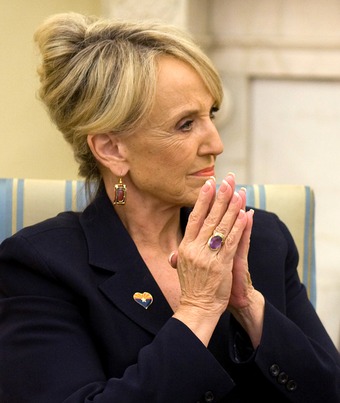
Jan Brewer
Jan Brewer, Governor of Arizona, who signed the controversial Suppor Our Law Enforcement and Safe Neighborhoods Act, which makes it a state misdemeanor crime for an immigrant to be in Arizona without carrying registration documents required by federal law.
Being the first state to pass such legislation, Arizona has set a precedent for other states. Nevertheless, this legislation has also caused Arizona to carry a large burden. Although the response has cost the state between 7 million and 52 million, some in the state still feel that this outcome will outweigh the initial cost. Due to conflict and protest, Governor Brewer signed House Bill 2162 (HB 2162) a week later, amending text in the original document. HB 2162 includes that race, color, and national origin would not play a role in prosecution; in order to investigate an individual’s immigration status, he or she must be “lawfully stopped, arrested or detained. “
Reform and Advocacy
In the absence of comprehensive immigration reform at the federal level, many advocacy groups have focused on improving the fairness and efficiency of the immigration court system. They propose incremental steps the executive branch can take to stop an assembly line approach to deportation proceedings. These groups have identified several issues that threaten the due process rights of immigrants, including reliance on low quality videoconferencing to conduct hearings, inadequate language interpretation services for non-English speakers, and limited access to court records. They also focus on problems arising out of the recent increase in immigration law enforcement without a commensurate boost in resources for adjudication. Other calls for reform include increased transparency at the Board of Immigration Appeals (BIA) and more diversity of experience among immigration judges, the majority of whom previously held positions adversarial to immigrants.
